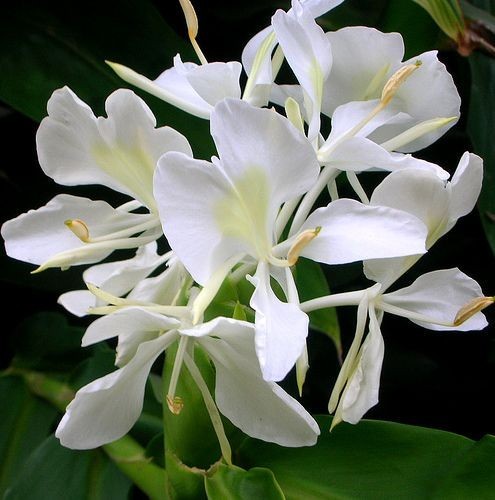#hawaii native plants
Text
Sometimes, Chris Hayes' podcast goes off on these weird tangents, and the most recent episode is one of them, quite explicitly. It's about the history of Polynesia, which is always a fascinating subject--the Polynesian expansion, and really the whole history of the Austronesian-speaking peoples, seems like one of those feats with rare equal in human history. It's one thing to roam over the vast steppes of Asia--it's quite another to take a canoe, stick some outriggers on it so it doesn't tip over, and start faring the open ocean.
One point his guest makes that I found interesting is that for the most part the atolls and little islands of the Pacific are a very harsh environment. Big volcanic archipelagoes like Hawaii and Aotearoa/New Zealand are rare. Atolls and other reef islands especially are functionally big limestone slabs, often without any source of fresh water, with no large mammals, and with few native plants you can eat. The weather is nice, sure (when there isn't a typhoon--and I can't help but think a typhoon on a little island must be terrifying indeed), but these are not inherently resource-rich places. That the Polynesian (and Micronesian and Melanesian!) peoples not only could travel those distances, but make permanent habitation on the islands they came across, is kind of crazy! You have to be really prepared, with a package of supplies and technologies that set you up for success. Long-distance trade is possible, but you're not gonna be running any kind of substantial import economy across hundreds or thousands of miles of ocean via catamarans.
The comparison that springs to mind to me isn't a historical one like the European age of exploration, which was overwhelmingly to places already peopled and productive, but to science fiction scenarios of space exploration. You'd have to have a little bit of the wild-eyed zealot to be the sort of person who ignores the cries of "there is no possible useful return on this investment" to settle most of these places. But they did! And they thrived for centuries!
2K notes
·
View notes
Text
"The U.S. government is entering a new era of collaboration with Native American and Alaska Native leaders in managing public lands and other resources, with top federal officials saying that incorporating more Indigenous knowledge into decision-making can help spur conservation and combat climate change.
Federal emergency managers on Thursday also announced updates to recovery policies to aid tribal communities in the repair or rebuilding of traditional homes or ceremonial buildings after a series of wildfires, floods and other disasters around the country.
With hundreds of tribal leaders gathering in Washington this week for an annual summit, the Biden administration is celebrating nearly 200 new agreements that are designed to boost federal cooperation with tribes nationwide.
The agreements cover everything from fishery restoration projects in Alaska and the Pacific Northwest to management of new national monuments in the Southwestern U.S., seed collection work in Montana and plant restoration in the Great Smoky Mountains.
“The United States manages hundreds of millions of acres of what we call federal public lands. Why wouldn’t we want added capacity, added expertise, millennia of knowledge and understanding of how to manage those lands?” U.S. Interior Assistant Secretary Bryan Newland said during a panel discussion.
The new co-management and co-stewardship agreements announced this week mark a tenfold increase over what had been inked just a year earlier, and officials said more are in the pipeline.
Newland, a citizen of the Bay Mills Indian Community in northern Michigan, said each agreement is unique. He said each arrangement is tailored to a tribe’s needs and capacity for helping to manage public lands — and at the very least assures their presence at the table when decisions are made.
The federal government is not looking to dictate to tribal leaders what a partnership should look like, he said...
The U.S. government controls more than a quarter of the land in the United States, with much of that encompassing the ancestral homelands of federally recognized tribes...
Tribes and advocacy groups have been pushing for arrangements that go beyond the consultation requirements mandated by federal law.
Researchers at the University of Washington and legal experts with the Native American Rights Fund have put together a new clearinghouse on the topic. They point out that public lands now central to the country’s national heritage originated from the dispossession and displacement of Indigenous people and that co-management could present on opportunity for the U.S. to reckon with that complicated legacy...
In an attempt to address complaints about chronic underfunding across Indian Country, President Joe Biden on Wednesday signed an executive order on the first day of the summit that will make it easier for tribes to find and access grants.
Deanne Criswell, administrator of the Federal Emergency Management Agency, told tribal leaders Thursday that her agency [FEMA] began work this year to upgrade its disaster guidance particularly in response to tribal needs.
The Indigenous people of Hawaii have increasingly been under siege from disasters, most recently a devastating fire that killed dozens of people and leveled an entire town. Just last month, another blaze scorched a stretch of irreplaceable rainforest on Oahu.
Tribes in California and Oregon also were forced to seek disaster declarations earlier this year after severe storms resulted in flooding and mudslides...
Criswell said the new guidance includes a pathway for Native American, Alaska Native and Hawaiian communities to request presidential disaster declarations, providing them with access to emergency federal relief funding. [Note: This alone is potentially a huge deal. A presidential disaster declaration unlocks literally millions of dollars in federal aid and does a lot to speed up the response.]
The agency also is now accepting tribal self-certified damage assessments and cost estimates for restoring ceremonial buildings or traditional homes, while not requiring site inspections, maps or other details that might compromise culturally sensitive data."
-via AP, December 7, 2023
#united states#us politics#natural disasters#disaster relief#public lands#land back#indigenous#native american#first nations#indigineous people#sovereignty#president biden#biden administration#hope#good news#land management
592 notes
·
View notes
Text
Research by Clay Trauernicht, a fire specialist at the University of Hawaii, and others has shown that the scale and frequency of wildfires have been increasing across in Hawaii from the early 1900s to the 2010s. The researchers also identified a major culprit: non-native plants.
“Wildfires were most frequent in developed areas, but most areas burned occurred in dry non-native grasslands and shrublands that currently compose 24 percent of Hawaii’s total land cover,” the researchers wrote. “These grass-dominated landscapes allow wildfires to propagate rapidly.”
The non-native grasses were brought to Hawaii by cattle ranchers in the 19th century, University of California Santa Barbara ecologist Carla D’Antonio told me. “They were selected because they were drought tolerant.”
They are also invasive. The abandoned sugar and pineapple farms across the state are quickly taken over by non-native grasses. “When the land gets abandoned, the grasses are the first invaders. All you need is a little drought to have a flammable landscape.” Maui is currently in a drought.
The grasses are an especially potent fuel, D'Antonio explained, because they grow quickly when it rains and then stick around, deeply rooted into the soil, as dry, dead organic matter, becoming a “standing layer of very ignitable fuel.”
Then after a fire, these non-native plants tend to do better than native ones, thus increasing future fire risk. Fire “has generally been shown to decrease the abundance of native woody plants because nonnative, invasive, fire-adapted plants out-compete natives for resources in the post-fire environment and tend to dominate post-fire communities,” according to a United States Forest Service review.
490 notes
·
View notes
Text
Seed Sources
I updated the sources list for 2024! Here is the Google Docs link for sharing off Tumblr. A lot of my gardening guides are written with the Pacific Northwest in mind, but this should useful for most folks on Turtle Island. For people elsewhere I'm not 100% sure how many of these are able to ship off-continent but it's worth checking out!
EDIT: I have found out the hard way that indented bullets do not work on Tumblr for web browser so I have tried my best to make them visually distinct. The Google Doc is formatted properly though.
General/Big Brand Seed Shops
Burpee Seeds
Ed Hume Seeds
Johnny’s Seeds
Renee’s Garden
Territorial Seed
Independent online fruit and veggie shops
(More exotics and rare cultivars)
Adaptive Seeds
Breeds plants specifically to adapt them to the Pacific Northwest
Alliance of Native Seedkeepers
Indigenous-owned seed company
Experimental Farm Network
A network of plant breeders with an extensive collection of unusual cultivars and species of edible plant that don’t commonly appear elsewhere.
Very reputable
Pro-Palestine
Fedco Seeds
Good on social justice issues and have awareness of white supremacy
Maui Seed Company
Lots of Hawaii-growing species, plus soaps!
Pricey
Smart Seeds Emporium
Some of the photos are enhanced stock photos which is a little annoying, but I have ordered from them
True Love Seeds
Works with Black and Indigenous populations to source seeds and does education projects regarding race and ethnicity
Contains unusual seeds from breeding projects
Pro-Palestine
Uprising Seeds
Pro-Palestine
Local to the Pacific Northwest
Succulents and Other Ornamentals
Mesa Garden
Smart Seeds Emporium
Lots of ornamentals in this shop as well as food plants
Germination can be inconsistent on some of their seeds
Avoid/Blacklist
Baker Heirloom Seeds
Take credit for seeds from other sellers, including Indigenous farmers.
Work with Cliven Bundy and upholds white supremacy
#plantblr#plants#resource#Remembered I had a seed sourcing list and figured I should update it for 2024 after making that post
129 notes
·
View notes
Text
In the late 18th century, [...] Lahaina carried such an abundance of water that early explorers reportedly anointed it “Venice of the Pacific”. A glut of natural wetlands nourished breadfruit trees, extensive taro terraces and fishponds that sustained wildlife and generations of Native Hawaiian families.
But more than a century and a half of plantation agriculture, driven by American and European colonists, have depleted Lahaina’s streams and turned biodiverse food forests into tinderboxes. Today, Hawaii spends $3bn a year importing up to 90% of its food. This altered ecology, experts say, gave rise to the 8 August blaze that decimated the historic west Maui town and killed more than 111 people.
“The rise of plantation capital spawned the drying of the west side of Maui,” said Kamana Beamer, a historian and a former member of the Hawaii commission on water resource management [...].
---
[S]ugar and pineapple white magnates began arriving on the islands in the early 1800s. For much of the next two centuries, Maui-based plantation owners like Alexander & Baldwin and Maui Land & Pineapple Company reaped enormous fortunes, uprooting native trees and extracting billions of gallons of water from streams to grow their thirsty crops. (Annual sugar cane production averaged 1m tons until the mid-1980s; a pound of sugar requires 2,000lb of freshwater to produce.)
Invasive plants that were introduced as livestock forage, like guinea grass, now cover a quarter of Hawaii’s surface area. The extensive use of pesticides on Maui’s pineapple fields poisoned nearby water wells. The dawn of large-scale agriculture dramatically changed land practices in Maui, where natural resources no longer served as a mode of food production or a habitat for birds but a means of generating fast cash, said Lucienne de Naie, an east Maui historian [...].
“The land was turned from this fertile plain – with these big healthy trees, wetland taros and dryland crops like banana and breadfruit – to a mass of monoculture: to rows and rows of sugar cane, and rows and rows of pineapple,” she said.
---
The Great Māhele of 1848, a ground-breaking law that legitimized private land ownership, laid the ground for big developers to hoard water for profit, said Jonathan Likeke Scheuer, a water policy consultant and co-author of the book Water and Power in West Maui. [...] [T]he creation of private property allowed agricultural corporations to wield “political and ultimately oligarchic power” over elected officials. In 1893, a group of sugar magnates and capitalists overthrew the Hawaiian Kingdom’s Queen Liliuokalani, paving the way for the US to annex Hawaii five years later. Sanford Ballard Dole, a cousin of Dole Plantation’s founder, served as the first governor of Hawaii.
When the last of the sugar companies closed in 2016 [...], Scheuer said, the farms were purchased by large investors for real estate speculation and left fallow, overrun with invasive grasses that became fuel for brush fires. Developers [...] took control of the plantations’ century-old irrigation ditches and diverted water to service its luxury subdivisions. In doing so, it left scraps for Indigenous families who lived downstream. [...] [O]n Maui, 16 of the top 20 water users are resorts, time-shares and short-term condominium rentals equipped with emerald golf courses and glittering pools [...].
---
Text by: Claire Wang. "How 19th-century pineapple plantations turned Maui into a tinderbox". The Guardian. 27 August 2023. [Bold emphasis and some paragraph breaks/contractions added by me.]
270 notes
·
View notes
Text
A writer’s guide to forests: woodlands made by man
Forests are for the most part, the realm of nature. But what about those with a less than natural origin? Here are some woodlands that are shaped artificially.
Parks and gardens- Trees look nice, there’s no denying it. As long as there have been people who admire trees, there have been gardens and parks. Grassy meadows, neatly trimmed hedges and flower beds may get all the attention, but an accenting grove, or a rambling woodland always adds to the aesthetic. Wealthy aristocrats would import trees from far away places, while more modest landowners and public spaces grow native species. Though the results do look quite natural, they are nonetheless human creations.
Orchard- Fruit and nut bearing trees have always been favored as a reliable source of food. And so people since nearly the beginning of agriculture have been planting orchards to provide for them. Trees are planted in rows, evenly spaced apart for the ease of harvesting. Smaller orchards, those catering to families who pick their own fruit, and those that grow fairly delicate fruits still do the harvesting by hand, while many more rely on machines to do the heavy lifting.
Tree farm/ plantation- Many trees types cultivated are deciduous species, but there are some instances when conifers are preferred. Being relatively fast growing, and usually possessing a single, straight trunk, they are the ideal tree type for use as lumber and paper products. Of course, one cannot forget the need every November and December for Christmas trees.
Palm plantation- The tropics are ideal for growing oil palms. Thousands of acres are devoted to the tree, as so much of our food and other products these days relies on palm oil. This is not a good thing as the demand means that vast areas of rainforest have had to be cleared. In Indonesia, the problem is particularly evident, as the growth of palm plantations is one of the main factors behind the decline of orangutan numbers.
Coconut grove- Almost anywhere you go in the tropics will have coconut palms. Buoyant, the nut floats easily on the currents, and where it is too isolated for a coconut to reach naturally (such as Hawaii), people have brought it with them. As well as the coconuts, the palms themsevles are also used; palm fronds can be used for roofing, and the fibers are used in weaving.
Bonsai forest- The art of growing miniature trees has been practiced for centuries. Some trees are collected in the wild, harsh natural conditions causing the trees to grow slowly and stay small, but many more are shaped over many years. While many bonsai are grown singularly, groves and forests are also popular choices. These can be either monospecific, or mixed, and can be part of a larger landscape creation that includes rocks, water, and figures.
There are plenty of examples of forest areas that are man-made. Don’t feel like you have to confine your story to a natural woodland. Use what you find around you to inspire the setting and drive your characters and the plot. What happens on the earth can easily be applied to science fiction or fantasy. Put your own spin on it (maybe your characters are small and live in a bonsai forest…of course they could also be normal sized people who happen to be in a giant sized bonsai planting).
Edit: As pointed out in the comments/reblogs, I seemed to have forgotten woodlots, so I am going to include those.
Woodlot- Common areas open to members of the community include a mixture of open pastureland and forested areas. People would have their flocks and herds forage here in spring and summer, whilst they managed and harvested the trees. Trees in woodlots would not be felled, instead the branches would be cut back and allowed to regrow. The resulting growth produces straight branches that are used in constructing walls, fences, as well as firewood and charcoal. (Communal pastures and woodlots are not really thought of these days, as many areas were lost over the years due to industrialization, urbanization, and the enclosure of land by the aristocracy)
#writing#creative writing#writing guide#writing inspiration#writing prompts#worldbuilding#writer#writers#writers and poets#writing community#writer on tumblr#writeblr
56 notes
·
View notes
Photo
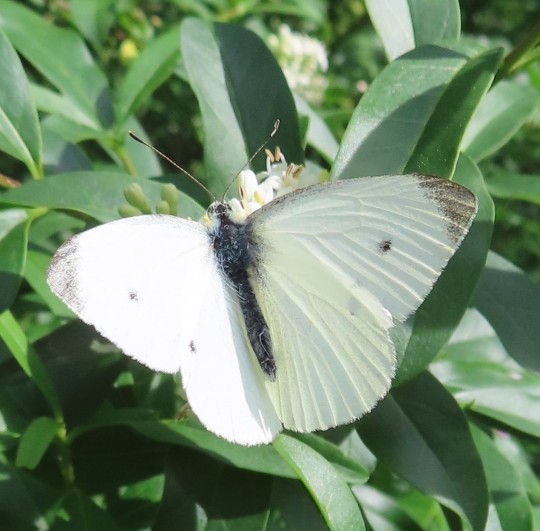


Ligustrum (privet) and Pieris rapae (cabbage white butterfly)
We have a very tall privet hedge which runs the length of our back fence and the back fences of our neighbors on either side. Yesterday, I cut it back as I do every year. The privet is allowed to grow up, as a privacy screen, but it’s not allowed to grow ‘out’ into my back lawn. As any gardener knows, sometimes plants need to be closely controlled.
Privets are from Asia. Although privet hedges are synonymous with English country gardens, everywhere else they grow in the world (except Asia) they’re a non-native species. This includes our back garden in Vancouver.
While on the subject of non-native species, the cabbage white butterfly has a natural range across Europe, Asia and North Africa. It was accidently introduced to Quebec in 1860 and is now commonly found throughout North America. By 1898, the cabbage white had spread to Hawaii. It reached New Zealand and Australia in 1929. It does not seem to have made it to South America yet. Incidentally, this one has two spots on each wing, so it’s a female.
#flowers#photographers on tumblr#privet hedge#cabbage white#butterfly#fleurs#flores#fiori#blumen#bloemen#our garden#Vancouver
121 notes
·
View notes
Photo
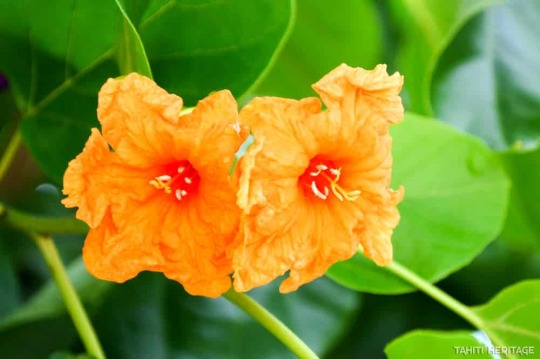
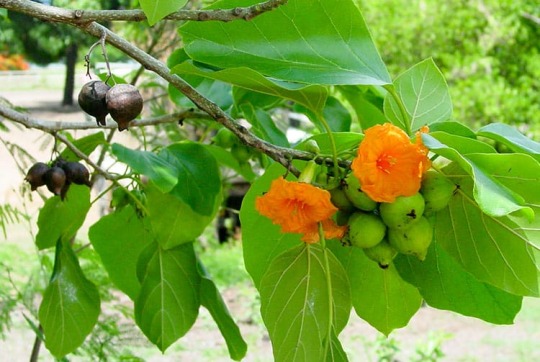

Tou, the tree that serves as a meeting point for the inhabitants
The Tou (Cordia subcordata) is native from East Africa to Eastern Polynesia and Hawaii. In French Polynesia, this tree is present in all the archipelagos but particularly in the Eastern Tuamotus. The Tou is confined to the coastal fringe of the high islands and develops well on the motu. In the Marquesas and in the Society, it is found up to 100 m altitude on rocky slopes.
The old Tou play an important role in many villages of Taumotu, since the inhabitants have become accustomed to meeting in the shade of these trees. Most were planted in 1906, just after the passage of cyclones that ravaged the villages.
Stocky tree, in flower and fruit all year round, with beige-gray bark that can reach more than 15 m in height and 1 m in diameter. The leaves are simple, alternate, oval, 7-30 cm long. The inflorescence comprises 5 to 20 funnel-shaped orange flowers more or less pleated. The fruits have the shape of a 2 cm long drupe of green to brown-black color when ripe. The dissemination of the fruits is ensured, thanks to their buoyancy, by the sea currents.
32 notes
·
View notes
Text
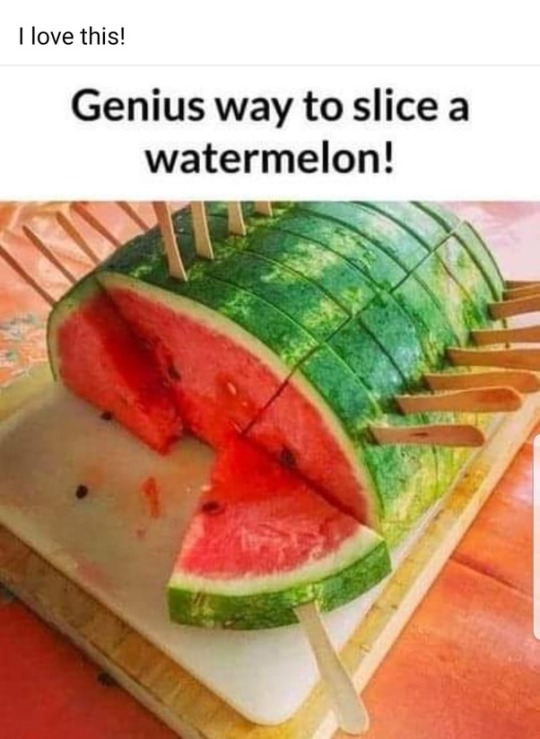
Kordofan melons from Sudan are the closest relatives and may be progenitors of modern, cultivated watermelons. Wild watermelon seeds were found in Uan Muhuggiag, a prehistoric site in Libya that dates to approximately 3500 BC. Watermelons were domesticated in north-east Africa, and cultivated in Egypt by 2000 BC, although they were not the sweet modern variety. Sweet dessert watermelons spread across the Mediterranean world during Roman times.
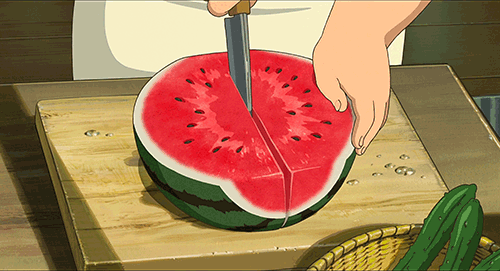
Many 5000-year-old wild watermelon seeds (C. lanatus) were discovered at Uan Muhuggiag, a prehistoric archaeological site located in southwestern Libya. This archaeobotanical discovery may support the possibility that the plant was more widely distributed in the past.
In the 7th century, watermelons were being cultivated in India, and by the 10th century had reached China. The Moors introduced the fruit into the Iberian Peninsula, and there is evidence of it being cultivated in Córdoba in 961 and also in Seville in 1158. It spread northwards through southern Europe, perhaps limited in its advance by summer temperatures being insufficient for good yields. The fruit had begun appearing in European herbals by 1600, and was widely planted in Europe in the 17th century as a minor garden crop.
Early watermelons were not sweet, but bitter, with yellowish-white flesh. They were also difficult to open. Through breeding, watermelons later tasted better and were easier to open.
European colonists and enslaved people from Africa introduced the watermelon to the New World. Spanish settlers were growing it in Florida in 1576. It was being grown in Massachusetts by 1629, and by 1650 was being cultivated in Peru, Brazil and Panama. Around the same time, Native Americans were cultivating the crop in the Mississippi valley and Florida. Watermelons were rapidly accepted in Hawaii and other Pacific islands when they were introduced there by explorers such as Captain James Cook. In the Civil War era United States, watermelons were commonly grown by free African people and became one symbol for the abolition of slavery. After the Civil War, African people were maligned for their association with watermelon. The sentiment evolved into a racist stereotype where Africn people shared a supposed voracious appetite for watermelon, a fruit long correlated with laziness and uncleanliness.
Seedless watermelons were initially developed in 1939 by Japanese scientists who were able to create seedless triploid hybrids which remained rare initially because they did not have sufficient disease resistance. Seedless watermelons became more popular in the 21st century, rising to nearly 85% of total watermelon sales in the United States in 2014

A melon from the Kordofan region of Sudan – the kordofan melon – may be the progenitor of the modern, domesticated watermelon. The kordofan melon shares with the domestic watermelon loss of the bitterness gene, while maintaining a sweet taste, unlike other wild African varieties from other regions, indicating a common origin, possibly cultivated in the Nile Valley by 4360 BP (before present)

#kemetic dreams#watermelon#wow#kordofan#sudan#ta seti#nubia#progenitor#nile valley#african#afrakan#africans#libya#north africa#african culture#north ifriqiya#ifriqiya#kordofan melon
24 notes
·
View notes
Text
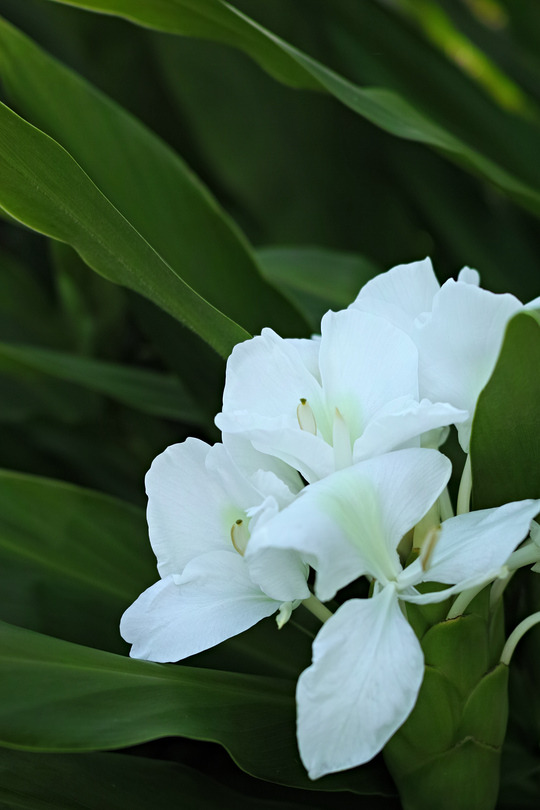
花縮砂[Hanashukusha]
Hedychium coronarium
花[Hana] : Flower
縮砂[Shukusha] : Name of the seeds of a plant called Amomum xanthioides in Chinese medicine
Ginger lily. It is native to South and Southeast Asia, and was introduced in 1851. In some areas it has become wild today.
It is so named because its seeds resemble those of Shukusha. The rhizomes are used for medicinal purposes, and the flowers, with their aromatic fragrance reminiscent of jasmine, are used to make perfume.
As a supplement, it is the national flower of Cuba and is called Mariposa, and they say, garlands, leis, are often made from its flowers in Hawaii.
23 notes
·
View notes
Text
Hawaiian Crow / 'Alalā — Corvus Hawaiiensis
For context i started this because i came across a post on my "For You" tab on my main ((Sharkthe-cat)) awhile back talking about an endangered lynx, and i think it said something about it being an animal of the day. If i find it, i'll link it here. But i loved that idea so i figured i'd do that myself, but with endangered organisms and languages, sort of as an outlet for my passion for ((endangered)) languages and my many researching sessions of endangered animals as a kid.
This will also likely take inspiration form the channel imshawn getoffmylawn, please check out his channel, it has lots of really cool videos on obscure and endangered languages, so you may find it of interest if you're a language nerd like me.
My main sources will be Wikipedia and the Ethnologue ((for languages from the Americas and the Pacific as i only have that version at the moment)), and i will attempt at posting once per day, alternating between both organisms and languages.
I always appreciate corrections, please let me know if i have gotten a fact wrong, if you have any other feedback, or literally have anything to say i'd love to know your thoughts on this :D
————————————————————————
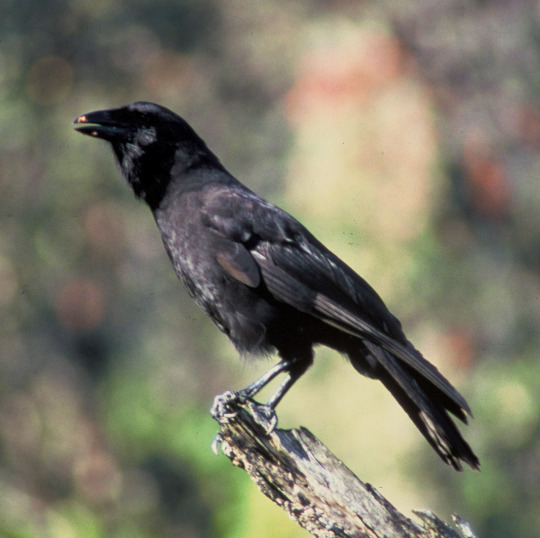
IUCN 3.1 status — EW (Extinct in the wild)
NatureServe status — GH (Possibly extinct)
Population: 120 (all in breeding programs)
Distribution: Hawai'i Island, Hawai'i, USA
"Family Tree:"
Family - Corvidae
Subgenus - Corvinae
Genus - Corvus
Etymology:
'Alalā is the Hawaiian word for to cry, bleat, squeal, bawl, etc., and the crow itself was given that name for its distinctive call.
Programs: Keahou and Maui Bird Conservation Centres
As with many other crows, Hawaiian crows are known for their intelligence and socialness. Captive individuals use sticks as tools to extract food from holes drilled in logs, and juveniles are known to use them without training or learning from others. They are regarded as 'aumākua, or family guardians, by some native Hawaiians.
The 'alalā are the most endangered species in the family corvidae and the only corvid left in Hawai'i, and they have been extinct in the wild since 2002. In the wild, their main predator was the Hawaiian hawk (which itself is near threatened). Most crows adapt very well to humans presence, but the 'alalā population has gone down drastically in their presence. Their population decreased due to various reasons, including deforestation (as with many other species), the introduction of non-native species (cats, dogs, mongooses, rats), and in particular, avian malaria, caused by deforestation allowing the rise of invasive plants and mosquitoes. They are considered to be an indicator species by scientists (a species that is used by scientists to represent the state of the area based on how well it's doing in its environment), and the absence of them has caused many plant species that rely on them to suffer as a result.
Bibliography:
https://en.wikipedia.org/wiki/Hawaiian_crow
https://volcanoheritagecottages.com/2021/11/13/the-recovery-story-of-hawaiis-revered-alala/
https://animals.sandiegozoo.org/animals/alala-hawaiian-crow
16 notes
·
View notes
Text
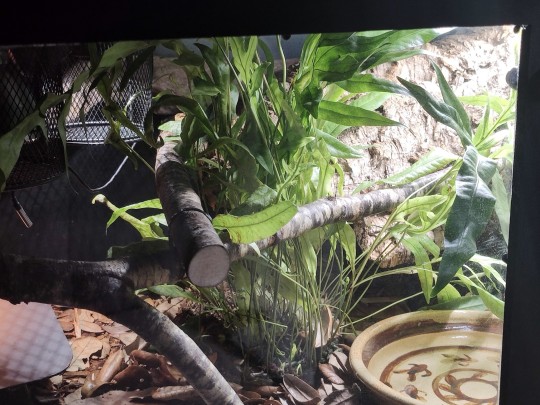

So, I wanted to get a larger plant for Keeva's enclosure, so I bought a Hawaiian fern. Without looking at the scientific name.
Apparently there are two ferns in Hawaii that go by the same name. A native fern, and then one that is endemic to Australia and a few other countries.
I accidentally got the second. You want to know what this fern's other common name is? Kangaroo foot fern.
That's right. Because I didn't read carefully, I ended up with That Damn Fern's twin (albeit a bit more sickly version. Shipping was not kind).
I couldn't find a good spot for it in Keeva's enclosure, so I stuck it in Ofeefee's, because why not commit to total insanity at this point. Keeva will get the Bonnie spider plant that was SUPPOSED to go in Ofeefee's enclosure.
Other than that, have some random snake pics. We should be making our way home from GA after picking up Aisling's enclosure when this posts





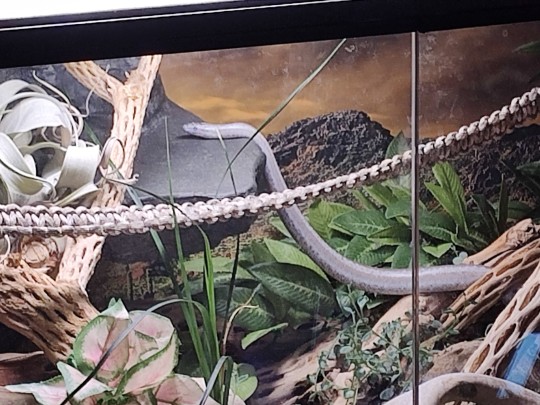
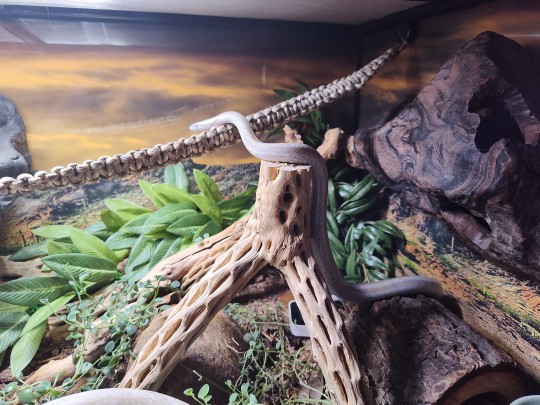

#reptiblr#reptiles#snakes#bioactive#ball python#corn snake#reptblr#rosy boa#african house snake#queue
22 notes
·
View notes
Note
It’s so nice to see you active! You’re always so interesting
Thanks! Let’s be interesting and discuss why Maui is actually on fire shall we?
Tourism
Introduction of non-native species
Water diversion for tourism
More water diversion
Plantations which are owned by the big 5
Other fucked up shit I hate:
Swiss family Robinson is based on the Robinson family who own the entire island of Niʻihau (if this Wikipedia page doesn’t just make you want to riot and vomit idk what will)
The loss of fully endemic (meaning found nowhere else on earth) plants and animals
Disrespect for cultural lands that is nearly never ending
I could seriously rant forever with rage but maybe you guys can learn something from this and spread the truth of what’s happening in Hawai’i. If you guys only knew… 🤢🤬
Oh yeah, also Hawaii is illegally occupied by the US government— oh and one of the big 5, you know Dole? Like the huge fruit manufacturer who grows pineapples (not native to Hawaii btw) and bananas? Well he was first governor…
Just like all the US where natives were brutally assimilated and removed from their ancestral lands because of “manifest destiny”
#ask box#hawaii#maui#capitalism isn’t working#capitalism is a curse#indigenous#native rights#illegal occupation of Hawaii
13 notes
·
View notes
Text
“The rise of plantation capital spawned the drying of the west side of Maui,” said Kamana Beamer, a historian and a former member of the Hawaii commission on water resource management, which is charged with protecting and regulating water resources. “You can see the link between extractive, unfettered capitalism at the expense of our natural resources and the ecosystem.”
Drawn to Hawaii’s temperate climate and prodigious rainfall, sugar and pineapple white magnates began arriving on the islands in the early 1800s. For much of the next two centuries, Maui-based plantation owners like Alexander & Baldwin and Maui Land & Pineapple Company reaped enormous fortunes, uprooting native trees and extracting billions of gallons of water from streams to grow their thirsty crops. (Annual sugar cane production averaged 1m tons until the mid-1980s; a pound of sugar requires 2,000lb of freshwater to produce.)
Invasive plants that were introduced as livestock forage, like guinea grass, now cover a quarter of Hawaii’s surface area. The extensive use of pesticides on Maui’s pineapple fields poisoned nearby water wells.
The dawn of large-scale agriculture dramatically changed land practices in Maui, where natural resources no longer served as a mode of food production or a habitat for birds but a means of generating fast cash, said Lucienne de Naie, an east Maui historian and chair of the Sierra Club Maui group.
“The land was turned from this fertile plain – with these big healthy trees, wetland taros and dryland crops like banana and breadfruit – to a mass of monoculture: to rows and rows of sugar cane, and rows and rows of pineapple,” she said.
[...]
In Hawaii, water is held in a public trust controlled by the government for the people. But on Maui, 16 of the top 20 water users are resorts, time-shares and short-term condominium rentals equipped with emerald golf courses and glittering pools, according to a 2020 report from the county’s board of water supply. The 40-acre Grand Wailea resort, the island’s largest water consumer, devoured half a million gallons of water daily – the amount needed to supply more than 1,400 single-family homes.
143 notes
·
View notes
Text
goofy hawaiian bird facts i learned from this book i read on a plane
* woodpeckers hate flying over water, so no woodpecker species has ever made it to hawaii. HOWEVER, nature abhors a vacuum, and that whole “gettin lil grubs n such outta tree bark” niche was ripe for the taking... so the woodpecker niche was filled by this guy:
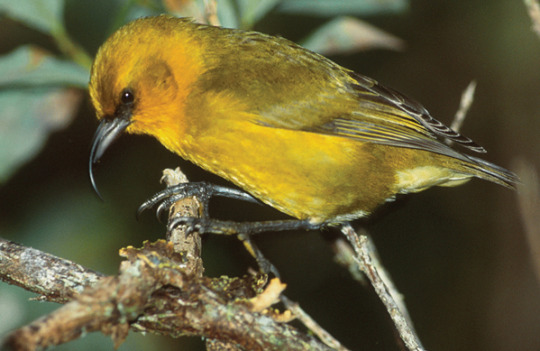
“what,” you may ask, “the heck.”
the ʻakiapōlāʻau is a member of the Hawaiian honeycreeper family, which is mostly evolved to drink nectar from flowers. but this dude figured out he could just... open his beak real wide... peck with only with the stumpy lower “jaw” of his beak... and get some extra food that way. thus he is a “wood” “pecker” lmao.
here’s a video of one pecking. cw goofy bird bein GOOFY AS HECK
* speaking of said honeycreeper family: the reason for their goofy curved beaks is not just specialized-adaptations-to-take-advantage-of-different-food-sources (as is classically the case in eg Darwin’s finches), but coevolution alongside Hawaii’s flowering plants! see, Hawaii doesn’t have any native bees or mosquitos, so the flowers desperately needed some sort of pollinators; ergo, they relied on birds bopping their heads in for some nectar and getting some pollen on their foreheads in the process.
it is most advantageous for the flowers if the bird has to work at it / struggle a bit to get the nectar (so that it shakes the flower and gets more pollen on itself in the process), but it is most advantageous for the bird if they have to do zero work. so you get native flowers evolving all kinds of weird, convoluted shapes to make it harder to sip their nectar, and birds evolving ever-curvier ever-goofier beaks to compensate. it’s kinda luck the duck-corkscrew-penis-thing but less uhhh visceral/brutal, lol
* i knew, vaguely, that most of Hawaii’s native avifauna are endangered due to habitat loss and predation from invasive species. what i didn’t realize is what a menace avian malaria is—probably a bigger factor in the population die-off than anything else. there’s huge parts of the islands where aggressive fencing has gotten predation/disruption by invasive species under control, but the birds are still facing massive population die-offs b/c they literally had none of these diseases until humans showed up. (which is more recent than i thought! the polynesians rolling in was only ~1000 years ago, and promptly extinct’d a bunch of the more dodo-like birds the island had at the time, haha.) there’s evidence that some of the honeycreeper species are finally developing resistance, which is great news (the ʻapapane, in particular, seems to have developed a lot of resistance in small population studies, and also its population is increasing & its range is expanding), but the ‘i’iwi still seem to be 100% vulnerable to the illness in small population studies, so. that + climate change (which will make the island warmer, thus extending the range of mosquitos further up into the mountains, which will spread the range of avian malaria even further) makes the prospects for 'i’iwis really grim, alas :(
* i thought most of the invasive bird species on Hawaii were brought over accidentally, like, escaped pets or whatever, but turns out they were mostly deliberately introduced by this one Hawaiian bird club (Hui Manu) during the 1930s onward lol. in particular, there were very few native birds left in the lowlands by then, people think birds are cool, they’re like there are no birds here so what if we bring our own... and now there’s, like, northern cardinals and house finches n shit right here in the middle of the pacific. rip
* Hawaii’s state bird, the Hawaiian goose (aka the nene), is actually a funny story amusing/uplifting conservation story. by the 1980s, they were basically extinct in the wild, and it’s super-embarrassing if your state bird goes extinct, so they were trying to reintroduce some captive flocks into the wild, right? they did some early reintroduction programs on Oahu and Maui, but they went poorly, in part because those islands have a serious mongoose problem (thanks to sugarcane farmers bringing them in to “help” “control” the rat population in the 1800s).
there was Kauai sitting right there, however, which had a mongoose population of 0. perfect! however, they hesitated to reintroduce the goose there, because they weren’t sure if the goose was actually native to that island, and by that time they’d finally become a lil gun-shy about reintroducing species willy-nilly based on vibes
however, the choice was taken out of their hands when a massive hurricane blew through in 1982, which blasted apart the enclosures for a captive flock on Kauai, which sent them scattering all over the island.
this flock positively thrived on Kauai, and happily, later fossil evidence confirmed that nene had in fact historically existed on the island, so it was indeed a reintroduction, and they’ve now been reestablished on Oahu and Maui as well. gogo nenes~
* apparently bristle-thighed curlews do the eclipse plumage thing that ducks do (where they molt all their feathers at once and are thus flightless for a period of time), and that’s part of why they’re hella endangered right now. they relied on those lil tiny pacific islands having zero predators, alas
* “the graceful and handsome Hawaiian Stilt, a relative of the Black-necked Stilt of North America, whose annoying hipping calls caused one spart-aleck to call it the ‘pond poodle’” lmao
* i knew about white terns, the goofy little cuties famed in bird memes because they just lay their eggs on tree branches with zero nest material or any other protection for the things. but did you know they specifically like to nest in... urban Honolulu? apparently the easiest way to find them is just go to their version of Central Park and look up to find the lil youngster yapping away from a big ol branch. awesome
anyway! hope you enjoyed this edition of Bird Facts TM
48 notes
·
View notes
